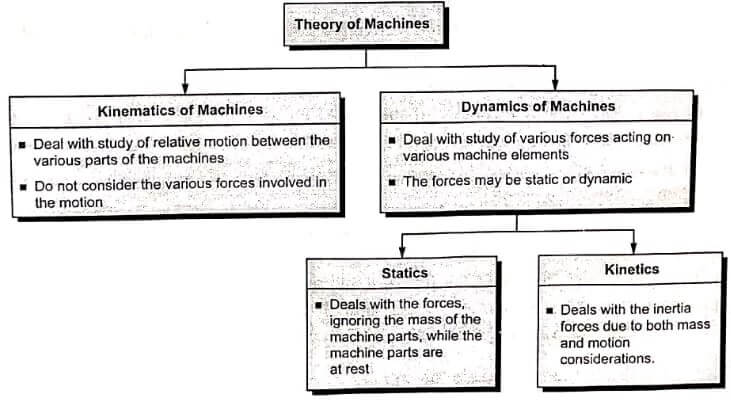The subject ‘Theory of Machines’, also known as ‘Mechanics of Machines’, comprises:
(i) the study of the relative motion between the parts of a machine, and
(ii) the study of the forces which act on those parts.
It is understood that most mechanical engineering activities revolve around a mechanical system whose function depends on the relative movements among its various members. The design of a mechanical system needs a proper understanding of: (i) the geometrical aspects of motion, and (in) the various forces involved in motion. The theory of machines subject tries to provide underlying theories and scientific principles behind the behavioural characteristics of all machines and mechanisms.
The major objectives of the subject theory of machines are to provide the engineers the necessary tools to systematically synthesize a system which means scientifically arriving at the critical shapes and dimensions of the bodies constituting the system.
Branches of Theory of Machines
- The ‘Theory of Machines’ subject may be divided into kinematics of machines and dynamics of machines, as shown in Fig.
- The definitions of above branches are summarised in Table
Definitions of various branches of theory of machine
| 1. Kinematics : It is a branch of Theory of Machines which deals with the study of relative motion between the various parts of the machines, without reference to the forces causing a body to move. Thus the kinematics is a study of geometry of motion (i.e., displacement, velocity, and acceleration of machine part). |
| 2. Dynamics : It is a branch of Theory of Machines which deals with the forces and their effects, while acting upon the machine parts in motion. (a) Statics: It is a branch of Theory of Machines which deals with the forces and their effects while the machine parts are at rest. The mass of the parts is assumed to be negligible. (b) Kinetics: a It is a branch of Theory of Machines which deals with the inertia forces which arise from the combined effect of the mass and motion of the machine parts. |
Illustration
The above divisions of the subject may be illustrated by considering the case of a reciprocating pump. In the reciprocating pump the piston reciprocates in cylinder due to the crank shaft which receives uniform rotation from a motor coupled to it. The pressure drop created inside the cylinder enables water to enter in during forward stroke and to be pumped out during return stroke. Thus the rotary motion of the crankshaft (which is the input) gets converted to output reciprocating motion of the piston P through the crank OC and connecting rod CP.
- Under the study of kinematics, the relative motion of various parts can be determined with respect to various positions of the crank. Only the lengths of a crank (r) and connecting rod (1), the angular position of the crank (0) and the speed of the crank shaft are necessary to determine the kinematics (i.e., velocities and accelerations of the different parts) of the problem.
- Under the study of statics, the force acting on the piston due to water and the reaction forces of different parts can be determined. For this, different parts are considered as pin jointed frames. Knowing the pressure and area of piston, the force acting on the piston at various positions may be determined; then by resolution of forces, we can also determine the various forces acting on other parts i.e., connecting rod, crank, etc of the pump.
- Under the study of kinetics, the inertia forces acting on various parts of the pump (due to motion arising out of the masses and mass moment of inertia of the moving parts) can be determined, with the help of Newton’s second law of motion.
- However, the net force on every part is a combination of static and dynamic analysis. The complete study may require identifying the cross-section of some parts to withstand these loads.
| Read More Topics |
| Static Vs Dynamic Balancing |
| Balancing of Rotating masses |
| Extruder screw type machine |
| NC Machine tool fixtures |
| Numerically controlled machine |






